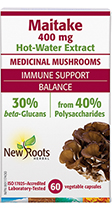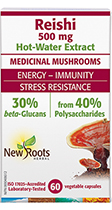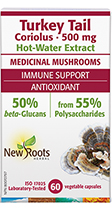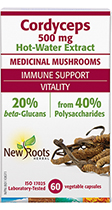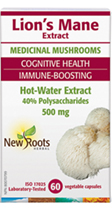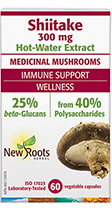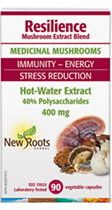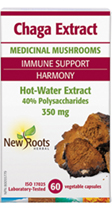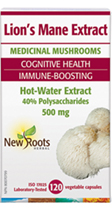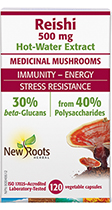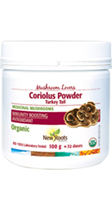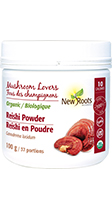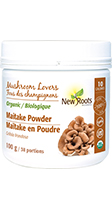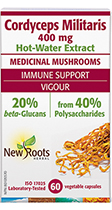Medicinal Mushrooms: Super Fungi to the Rescue!
One of Mother Nature’s finest creations emerges from the base of tree trunks and is buried in deep, dark soil. Mushrooms have been foraged for centuries, and have historically been found to have immunomodulating properties related to cancer and chronic diseases.[1]
These days, the most common mushrooms seen at family-dinner tables are less than extraordinary. White and brown button mushrooms hold their weight in fibre, but less so in the heavily concentrated medicinal constituents that are packaged and placed on shelves today.
The Immune System (An Overview)
The immune system is comprised of the innate system, which uses natural killer (NK) cells and phagocytes, and the adaptive immune system,[2] which employs T cells and B cells. When an unknown pathogen is introduced to the body, the innate immunity activates NK cells and phagocytes to destroy the invader. The adaptive immune system, with its B and T cells, then stores the identification of the pathogen so that the next time they try to attack, the response is faster and more robust.
Active Constituents of Medicinal Mushrooms
So, what makes certain mushrooms medicinal? All immunomodulating substances have the same end goal: To eliminate any threat to the body’s defence system. Medicinal mushrooms are no different. They contain a wide variety of constituents that serve to increase the number of NK cells, phagocytes, and B cells or T cells, so that any invader does not wreak havoc on the body.[3] Main active constituents are antioxidant phenolic compounds (fighting free radicals), anti-inflammatory terpenoids, and immunomodulating polysaccharides (IPS) including the popular beta-glucans, which stimulate the upregulation of immune cells.[4] Unfortunately, these polysaccharides are encased in chitin, which stops them from being absorbed by our intestinal mucous membrane.
Hot-Water Extraction: Pure and Potent
Medicinal mushrooms are available as whole fruiting body (fresh, dehydrated, or ground into powders) that can be used in meal preparation, or as extracts in supplement form. New technology has improved on traditional methods, allowing for more potent and pure therapeutic doses of medicinal mushrooms.
The process of botanical extraction most commonly uses hot water—and sometimes alcohol—to isolate the constituent. Mushrooms contain both water-soluble and alcohol-soluble constituents. The polysaccharides, including beta-glucans, are highly water-soluble; on the other hand, phenolic compounds and terpenoids are best extracted in alcohol. Since polysaccharides are tightly bound within the fungal cell walls, hot water is needed to dissolve the indigestible fibre (i.e., chitin).[5] This liquid extract is then dried into a potent powder, and commonly encapsulated.
Studies that use hot-water extracts demonstrate immune upregulation. In contrast, studies that use alcohol extracts show the downregulation of immune-cell activity. This is likely due to the decreased potency of the IPS in alcohol extracts.[6] In the case of medicinal mushrooms, polysaccharides are the star constituent for immune-enhancing properties, and hot-water extraction will provide the highest possible concentration.
Mushrooms for Immunity and Longevity
Reishi (Ganoderma lucidum)
With over 400 active constituents, reishi boasts an impressive résumé as an immune enhancer.[7] Used for centuries in Chinese medicine and reserved as a delicacy only for emperors, reishi has been studied for anxiety, fatigue, and primarily anticancer effects. Its IPS mobilize an army of NK cells, and its triterpenes decrease inflammation. Reishi also contains germanium, which oxygenates cells and neutralizes pain during the end stages of cancer.[8] In clinical trials, six months of reishi supplementation increased antioxidant content within the body and notably decreased incidence of fatty liver disease.[9]
What Are Reishi Spores?
Spores are germ cells that are ejected from the cap of the fungus once mature, allowing the mushroom to replicate and grow. Think of them as miniature seeds. G. lucidum spores contain similar active constituents as those found in the fruiting body (the mushroom itself) and provides comparable therapeutic benefits. Amazingly, over 29 triterpenes have been isolated from G. lucidum spores, while only a few have been found in the fruiting body.[10], [11] Also, more than 40% of the spore content is composed of IPS. The clinical applications of reishi spores are still being studied, but it is holding its weight in immune-enhancing, neuroprotective, antiepileptic, anxiolytic, antitumour, and liver-optimization abilities.[12], [13] Reishi spores may be the next ultimate superfood due to the higher bioavailability of active constituents.
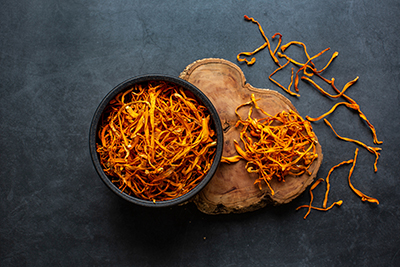 Cordyceps (Cordyceps militaris and Paecilomyces hepialis)
Cordyceps (Cordyceps militaris and Paecilomyces hepialis)
Both of these cordyceps species are grown and cultivated to perform similar therapeutic applications of their wild cousin, Cordyceps sinensis.
Traditionally used for fatigue and improving lung function, cordyceps have a high IPS content. In eight weeks, supplementation with cordyceps increased NK-cell activity while also activating T cells against tumour cells.[14] Cordyceps also increases oxygen utilization by stimulating red blood cell formation. After three weeks of cordyceps supplementation, maximal oxygen consumption (V̇O2 max) and tolerance to high-intensity interval training (HIIT) increased.[15] These studies are promising for individuals suffering with lung-health issues.
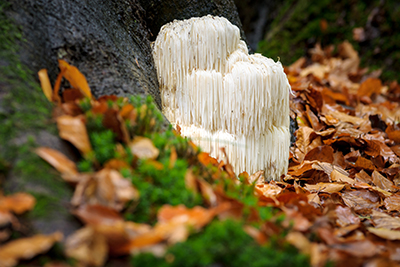 Lion’s Mane (Hericium erinaceus)
Lion’s Mane (Hericium erinaceus)
Perhaps the most luscious-looking medicinal mushroom and most easily found in nature, lion’s mane enhances the immune system and exhibits neuroprotective effects. The IPS in H. erinaceus has been shown to increase the efficacy of chemotherapy agents as well as decrease oxidative damage in healthy cells.[16]
More recently, H. erinaceus has emerged as a nootropic agent used to prevent dementia. The diterpenoids found in H. erinaceus promote the nerve growth factor (NGF), stimulating the growth of neurons and protecting brain cells from oxidative damage.[17]
Conclusion
It’s safe to say that medicinal mushrooms—in any form—are beneficial to long-term health. Therapeutic benefits are maximized by taking a hot-water extract with validated polysaccharide and beta-glucan content. When starting supplementation with a medicinal mushroom, some people can experience cleansing reactions like pimples, sore muscles, dizziness, and bowel changes.[18] These symptoms can signify an upregulation of the immune system and detoxification, and normally disappear within a short time frame. Naturopathic doctors can help you choose proper dosing. Superfungi are extraordinary creatures, but like many botanicals, concentrated doses and duration of use will ultimately result in robust immunity and longevity.[19]
 Dr. Patricia Wu, ND
Dr. Patricia Wu, ND
Dr. Wu is a naturopathic physician with a geriatric-focused practice in Tsawwassen (South Delta), BC. She has a special interest in heart disease, metabolic disease, and brain health (dementia/Alzheimer’s prevention).
drpatriciawu.com
[1] Cheung, P.C.K. “The nutritional and health benefits of mushrooms.” Nutrition Bulletin, Vol. 35, No. 4 (2010): 292–299.
[2] Nicholson, L.B. “The immune system.” Essays in Biochemistry, Vol. 60, No. 3 (2016): 275–301.
[3] Chakraborty, I., I.K. Sen, S. Mondal, D. Rout, S.K. Bhanja, G.N. Maity, and P. Maity. “Bioactive polysaccharides from natural sources: A review on the antitumor and immunomodulating activities.” Biocatalysis and Agricultural Biotechnology, Vol. 22 (2019): 101425.
[4] Siu, K.-C., X. Chen, and J.-Y. Wu. “Constituents actually responsible for the antioxidant activities of crude polysaccharides isolated from mushrooms.” Journal of Functional Foods, Vol. 11 (2014): 548–556.
[5] Zivanovic, S., and R. Buescher. “Changes in mushroom texture and cell wall composition affected by thermal processing.” Journal of Food Science, Vol. 69, No. 1 (2004): SNQ44–SNQ49.
[6] Martel, J., Y.-F. Ko, D.M. Ojcius, C.-C. Lu, C. J. Chang, C.-S. Lin, H.-C. Lai, and J.D. Young. “Immunomodulatory properties of plants and mushrooms.” Trends in Pharmacological Sciences, Vol. 38, No. 11 (2017): 967–981.
[7] Boh, B., M. Berovic, J. Zhang, and L. Zhi-Bin. “Ganoderma lucidum and its pharmaceutically active compounds.” Biotechnology Annual Review, Vol. 13 (2007): 265–301.
[8] Ahmad, M.F. “Ganoderma lucidum: Persuasive biologically active constituents and their health endorsement.” Biomedicine & Pharmacotherapy, Vol. 107 (2018): 507–519.
[9] Ahmad, “Ganoderma lucidum.”
[10] Deng, Y., J. Ma, D. Tang, and Q. Zhang. “Dynamic biomarkers indicate the immunological benefits provided by Ganoderma spore powder in post-operative breast and lung cancer patients.” Clinical & Translational Oncology, Vol. 23, No. 7 (2021): 1481–1490.
[11] Sliva, D., M. Sedlak, V. Slivova, T. Valachovicova, F.P. Lloyd Jr, and N.W.Y. Ho. “Biologic activity of spores and dried powder from Ganoderma lucidum for the inhibition of highly invasive human breast and prostate cancer cells.” The Journal of Alternative and Complementary Medicine, Vol. 9, No. 4 (2003): 491–497.
[12] Wang, G.-H., X. Li, W.-H. Cao, J. Li, and L.-H. Wang. “A retrospective study of Ganoderma lucidum spore powder for patients with epilepsy.” Medicine, Vol. 97, No. 23 (2018): e10941.
[13] Xu, J., and P. Li. “Researches and application of Ganoderma spores powder.” Advances in Experimental Medicine and Biology, Vol. 1181 (2019): 157–186.
[14] He, B.-L., Q.-W. Zheng, L.-Q. Guo, J.-Y. Huang, F. Yun, S. S. Huang, and J.-F. Lin. “Structural characterization and immune-enhancing activity of a novel high-molecular-weight polysaccharide from Cordyceps militaris.” International Journal of Biological Macromolecules, Vol. 145 (2020): 11–20.
[15] Hirsch, K.R., A.E. Smith-Ryan, E.J. Roelofs, E.T. Trexler, and M.G. Mock. “Cordyceps militaris improves tolerance to high-intensity exercise after acute and chronic supplementation.” Journal of Dietary Supplements, Vol. 14, No. 1 (2017): 42–53.
[16] Kushairi, N., C.W. Phan, V. Sabaratnam, P. David, and M. Naidu. “Lion’s mane mushroom, Hericium erinaceus (Bull.: Fr.) Pers. suppresses H2O2-induced oxidative damage and LPS-induced inflammation in HT22 hippocampal neurons and BV2 microglia.” Antioxidants, Vol. 8, No. 8 (2019): 261.
[17] Li, I.-C., L.-Y. Lee, T.-T. Tzeng, W.-P. Chen, Y.-P. Chen, Y.-J. Shiao, C.-C. Chen. “Neurohealth properties of Hericium erinaceus mycelia enriched with erinacines.” Behavioural Neurology, Vol. 2018 (2018): 5802634.
[18] Martel et al, “Immunomodulatory properties of plants and mushrooms.”
[19] Martel et al, “Immunomodulatory properties of plants and mushrooms.”

 Stores
Stores
